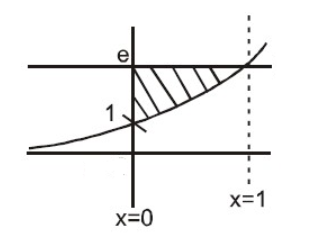
Area bounded by $y = {e^x}$ and lines x=0 and y=e is given by:
(This question has multiple correct options)
A. $e - \int\limits_0^1 {{e^x}dx} $
B. $e - \int\limits_1^e {\ln ydy} $
C. $e - 1$
D. $1$
Answer
577.2k+ views
Hint: To solve this question, we need to know the basic theory related to the area under a curve. As we know the area under a curve that exists between two points can be calculated by conducting a definite integral between the two points. Here we have a curve $y = {e^x}$. First, we will shade the region which consists of Area bounded by $y = {e^x}$ and lines x=0 and y=e as shown below and then after apply definite integral between the two points.
Complete step-by-step answer:
As we know, the area under the curve y = f(x) between x = a & x = b, one must integrate y = f(x) between the limits of a and b.

In the above figure, Area bounded by $y = {e^x}$ and lines x=0 and y=e is represented as a shaded region of the graph.
From figure we conclude that-
In the graph, the upper curve will be y = e and the lower one will be $y = {e^x}$.
Required area is,
A = $\int\limits_1^e {\ln ydy} $
= $e - \int\limits_0^1 {{e^x}dx} $
= $e - \left( {{e^x}} \right)_0^1$
= $e - \left( {e - 1} \right)$
= e – e + 1
= 1
Therefore, option (A) and (D) are the correct answer.
Note: Always remember that the first and the most important step is to plot the two curves on the same graph. If one can’t plot the exact curve, at least an idea of the relative orientations of the curves should be known.
Complete step-by-step answer:
As we know, the area under the curve y = f(x) between x = a & x = b, one must integrate y = f(x) between the limits of a and b.

In the above figure, Area bounded by $y = {e^x}$ and lines x=0 and y=e is represented as a shaded region of the graph.
From figure we conclude that-
In the graph, the upper curve will be y = e and the lower one will be $y = {e^x}$.
Required area is,
A = $\int\limits_1^e {\ln ydy} $
= $e - \int\limits_0^1 {{e^x}dx} $
= $e - \left( {{e^x}} \right)_0^1$
= $e - \left( {e - 1} \right)$
= e – e + 1
= 1
Therefore, option (A) and (D) are the correct answer.
Note: Always remember that the first and the most important step is to plot the two curves on the same graph. If one can’t plot the exact curve, at least an idea of the relative orientations of the curves should be known.
Recently Updated Pages
A man running at a speed 5 ms is viewed in the side class 12 physics CBSE

The number of solutions in x in 02pi for which sqrt class 12 maths CBSE

State and explain Hardy Weinbergs Principle class 12 biology CBSE

Write any two methods of preparation of phenol Give class 12 chemistry CBSE

Which of the following statements is wrong a Amnion class 12 biology CBSE

Differentiate between action potential and resting class 12 biology CBSE

Trending doubts
What are the major means of transport Explain each class 12 social science CBSE

Which are the Top 10 Largest Countries of the World?

Draw a labelled sketch of the human eye class 12 physics CBSE

Explain sex determination in humans with line diag class 12 biology CBSE

Explain sex determination in humans with the help of class 12 biology CBSE

Differentiate between homogeneous and heterogeneous class 12 chemistry CBSE




